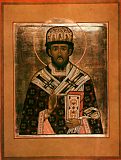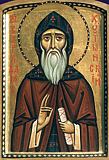

| Previous day | Next day |
| Old Style
November 6
|
Tuesday |
New Style
November 19
|
| 22nd Week after Pentecost. Tone 4. | No fast.
|
![]() Paul the Confessor, archbishop of Constantinople (350).
Paul the Confessor, archbishop of Constantinople (350). ![]() St. Barlaam, founder of Khutyn Monastery (Novgorod) (1192).
St. Barlaam, founder of Khutyn Monastery (Novgorod) (1192).
Virgin-martyrs Tecusa, Alexandra, Claudia, Matrona, Polactia, Euphrosyne, and Athanasia, of Ancyra (303). St. Luke, monk, of Sicily (820). St. Luke, steward of the Kiev Caves (13th c.). St. Herman, archbishop of Kazan (1567). St. Barlaam of Keret (Karelia) (16th c).
New Hieromartyrs Nicetas (Delektorsky), bishop of Orekhovo-Zuevsk, Barlaam (Nikolsky), abbot, of Andreyevskoe (Moscow), Gabriel (Vladimirov), hieromonk of the St. Michael Skovorodsky Monastery (Novgorod), Gabriel (Gur), hieromonk, of Lytkarino (Moscow), and Arsenius Troitsky, archpriest, of Vlasovo (Moscow) (1937). New Nun-martyrs Seraphima (Gorshkova) of Novodevichy Convent (St. Petersburg) and Nina (Shuvalova) of Chimkent (Kazakhstan) (1937). Synaxis of the New Martyrs of Sarov: Anatole, Basil, Hierotheus, Isaac, and Rufinus (1938).
St. Illtyd, abbot, of Llanilltyd Fawr, Wales (505). St. Leonard of Noblac (Gaul) (ca. 559). St. Winnoc, abbot, of Flanders (716). St. Cowey of Portaferry, abbot, of Moville Monastery (8th c.). St. Demetrianus, bishop of Cytheria on Cyprus (ca. 915). St. Elias Fondaminsky of Paris (1942).
Commemoration of the Sarov Elders: Abbot Pachomius (1794), Hieroschemamonk Joseph (1785), Hieromonks Pitirim (1789) and Matthew (1795), and Monk Joachim (1802).
Thoughts for Each Day of the Year
According to the Daily Church Readings from the Word of God
By St. Theophan the Recluse

Tuesday. [II Thess. 1:10-2:2; Luke 12:42-48]
The parable about the steward shows how a Christian should behave with relation to worldly things. A steward diligently does his work, but in his heart he is not attached to anything, he is free from all bonds, he relates to everything outwardly. So also must a Christian be in relation to all worldly things. But is this possible? It is possible. As there exists outward piety without inner piety, so worldliness which is only outward is possible without inner bonds. But in such a case, will everything around us turn into a single lifeless form, emitting coldness like a marble statue? No; in the midst of worldly things another life will develop which is more attractive than the fullest worldliness. Worldly things, being worldly things, truly will remain as the form, while that which warms the heart will start to proceed from another source, and whosoever drinketh from this source will no longer thirst. But then, is it better to drop everything? Why? Even one who outwardly drops everything can still be attached in his heart, and one who does not outwardly drop everything can be free from bonds. Of course it is more convenient for one who outwardly renounces everything to control his heart. Choose what is more convenient for you; just be disposed as the Lord commands.
Articles
 Venerable Luke of SicilySaint Luke of Sicily was a native of the Sicilian city of Tauromenium. |
 Second Translation of the relics of St Herman the Archbishop of Kazan |
 Saint Barlaam of KeretskSaint Barlaam of Keretsk served during the sixteenth century as a priest in the Keretsk area of the Kolsk peninsula on the White Sea. |
 Saint Barlaam of KeretskSaint Barlaam of Keretsk served during the sixteenth century as a priest in the Keretsk area of the Kolsk peninsula on the White Sea. |
 Orthodoxy in the Low Countries. Part 3: Great Monastic Saints and PenitentsMatthew HartleyWe now turn to some of the great monastic figures of the Low Countries. |






